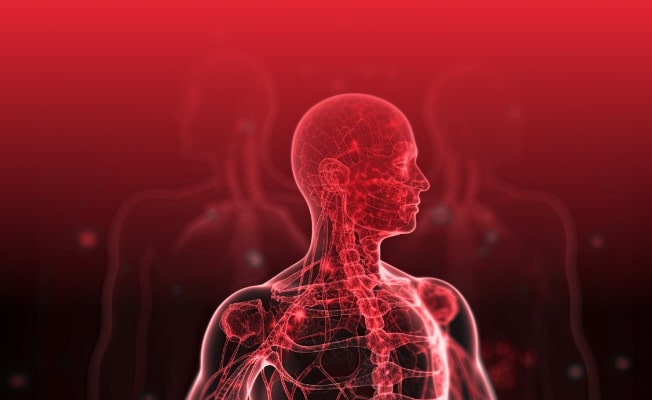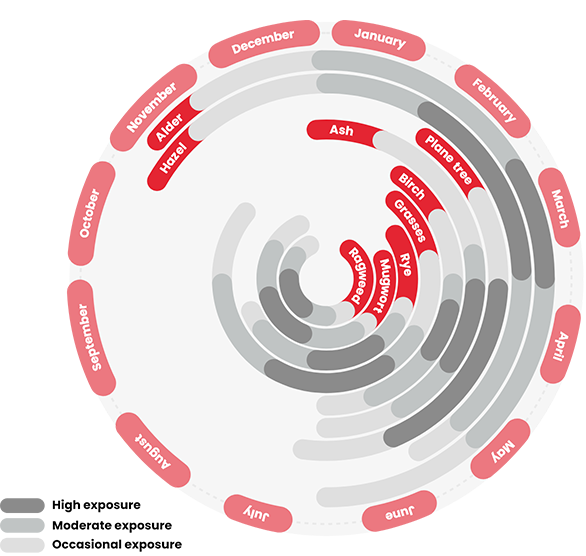
Therapy / Allergostop
allergostop®
In our modern society, allergies are on the rise. Possible causes include changes in lifestyle and diet, as well as increasing environmental influences. The symptoms and manifestations of allergies are extremely diverse. It is therefore no wonder that many sufferers do not receive a clear diagnosis, even after lengthy examinations. This is where we come in and show an innovative way forward: ALLERGOSTOP® – a special form of homoeopathic autologous blood therapy.
Do you suffer from allergic symptoms? Are pollen, animal hair, food, or other allergy triggers troubling you? Would you like to finally return to your everyday life without any allergy problems?
Click below for answers to your questions.
Contents:

What is ALLERGOSTOP®?
ALLERGOSTOP® therapy is a special form of homoeopathic autologous blood therapy, also known as counter-sensitization (in German: Gegensensibilisierung) as per Dr. Theurer. The method is based on an autologous blood preparation produced according to established homoeopathic guidelines.
ALLERGOSTOP® offers you an individual, gentle, and well-tolerated treatment option from naturopathy. Unlike many conventional therapy approaches, ALLERGOSTOP® can be used even if it is unclear what the patient is allergic to, or if several allergies are present at the same time. The allergy symptoms can likewise be non-specific. The therapy does not require long planning and can begin immediately when the allergic symptoms are at their worst. Homoeopathic autohaemotherapy can be used for allergy sufferers of all ages, as well as for persons with autoimmune diseases.
The aim of homoeopathic autohaemotherapy is to render harmless pathological antibodies, which play a central role in allergies and autoimmune diseases. ALLERGOSTOP® uses a simple trick to achieve this:
it uses the body’s own defence reaction!
How does ALLERGOSTOP® work?
Blood is sampled from the patient in the acute stage of the respective condition, i.e. when the allergic symptoms are strongest. This timing is crucial, because at this time the blood contains the antibodies specific to the condition at high concentrations. By addition of a serum activator, the allergic antibodies present in the blood are changed in such a way that they are later recognised by the body as foreign and therefore worth combating. After reinjection of the modified autologous blood, the body itself now forms antibodies against the pathological antibodies. These new antibodies are referred to as anti-antibodies. The original allergic antibodies are thereby reduced to such an extent that they can no longer trigger allergy symptoms. ALLERGOSTOP® can thus tackle cause and symptoms at the same time. Homoeopathic autohaemotherapy works in a similar way for autoimmune diseases – except that it is antibodies directed against the body’s own structures that are modified. Here, too, the body can help itself if specifically instructed to do so.
What benefit does ALLERGOSTOP® offer?
The allergens do not need to be known, so no allergy testing is required, and the allergy symptoms can also be non-specific. In addition, this form of homoeopathic autohaemotherapy can be used to deal with multiple allergens, if present. It is also important to mention that side effects in the form of intolerance reactions are rare with this homoeopathic autohaemotherapy. The modified autohaemotherapy simultaneously alleviates the symptoms and directly addresses the cause of the allergy.
How is treatment with ALLERGOSTOP® administered?
The right time to start treatment is when the allergy is at its maximum and the allergy symptoms are strongest, for at this stage the blood has a high level of antibodies specific to the condition. Allergen determination as in hyposensitisation is unnecessary. After a small amount of blood has been taken, it is processed by the therapist using the ALLERGOSTOP®-KIT. A homoeopathic dilution series is prepared, which is re-injected into the patient twice to thrice a week over a period of 3–5 weeks. In most cases, the first improvements set in after just two to three treatments with this homoeopathic autohaemotherapy. For patients who develop various allergies throughout the year, blood is taken several times, processed gradually, and then combined to form an ALLERGOSTOP® series. In this way, several allergies can be treated at the same time. This saves time, money, and effort!
Areas of application of ALLERGOSTOP®
Treatment with the patient’s own blood is often used for reprogramming in diseases involving the immune system. In addition to allergies and autoimmune diseases, allergic asthma and rheumatism are typical areas of application for homoeopathic autohaemotherapy. However, ALLERGOSTOP® should be used only in conjunction with existing medication, i.e. homoeopathic autohaemotherapy with immunosuppressants should be administered only after consultation with the attending physician.

Pollen allergy
Hay fever
Food allergy
House dust mite allergy
Animal hair allergy
Allergic rhinitis
Allergic sinusitis
Allergic dermatosis

Rheumatoid arthritis
Hashimoto’s thyroiditis
Lupus erythematosus
Multiple sclerosis
Crohn’s disease
Ulcerative colitis
Raynaud’s syndrome
Sjögren’s syndrome
Allergies:
Their triggers and their consequences

Pollen

Animal hair

House dust mites

Foodstuffs

Hay fever

Allergic rhinitis

Allergic sinusitis
An allergy, such as hay fever, is an overreaction of the immune system to a substance that is actually completely harmless to humans. However, the immune system of allergy sufferers mistakenly believes it to be harmful. In order to defend itself, it forms antibodies against these antigens and fights them.
This leads to the familiar symptoms of allergy. The most common allergens are pollen (hay fever), animal hair, house dust mites and food. In addition to a hereditary disposition, allergies can be triggered by stress, smoking and external environmental factors.
Mere nuisance or serious threat?
In industrialised countries such as Germany, up to one-quarter of the population suffer from allergic rhinitis, one of the most common allergic symptoms. Genetic predisposition plays a major role here. This is aggravated by pollutants in the air, which are on the rise and therefore promote allergies. The first symptoms usually occur before the age of 20. As long as the symptoms do not lead to impairment, they are often accepted, or attempts are made to suppress the symptoms with anti-allergic drugs. However, in some cases, hay fever evolves into allergic asthma after a few years.
By now at the latest, allergies become a serious challenge. Allergic asthma manifests as cramping of the bronchial muscles and, in acute asthma attacks, shortness of breath. Allergic asthma can develop from a common allergy and carries many risks. But allergic asthma is not the only source of danger. Over time, the allergy can also develop into a so-called cross-allergy to certain foodstuffs.

Hay fever - violent reaction to harmless pollen
Many people get hay fever as soon as the trees and plants bloom in spring.
Patients diagnosed with allergic asthma then also have more frequent asthma attacks than usual.
For all of them, pollen in the air triggers allergy symptoms in the upper respiratory tract.
Hay fever is also known as allergic rhinitis.
Allergy symptoms are caused by an overreaction of the immune system to harmless substances such as proteins from pollen.
Such substances are called allergens.
Hay fever is a type I allergy (immediate type).
They are mediated by class E immunoglobulins (IgE).
The antibodies bind to high-affinity IgE receptors, which are located on the mast cells, among other things.
The allergen can bind to the mast cells via the receptor-antibody complex and activate them.
This releases histamine and other messenger substances (cytokines) as well as pro-inflammatory substances that trigger allergic symptoms such as sneezing or itching.


Conventional medical therapies for hay fever and other allergies
Medication such as antihistamines or cortisone can provide rapid relief from the symptoms.
However, this is only a treatment for the allergy symptoms and will not eliminate the actual cause of the illness. In addition, prolonged use of the medication can lead to side effects (e.g. water retention). Those affected often also complain of tiredness when taking such medication.
If the allergen is known, hyposensitisation can be considered. Specific immunotherapy uses long-term therapy (3 to 5 years) to treat allergies to a few selected allergens, such as bee and wasp venom or pollen of certain tree or grass. Repeated administration of the allergen in a highly diluted dose, which does not yet trigger an allergic reaction, is supposed to lead to habituation to the allergen and thus end the excessive immune reaction to the allergen in the long term. Experience has shown that hyposensitisation reaches its limits if the allergy-triggering substance is unknown, or if several (multiple) allergies are present. There is also the major risk of triggering an anaphylactic shock.
Autoimmune diseases:
Their triggers and their consequences

What happens in autoimmune disease?
The mechanism of autoimmune disease is basically the same as that of allergy. Instead of antibodies against triggering antigens, autoantibodies are formed – i.e. antibodies against the body’s own structures. The body thus attacks its own healthy structure. In addition to genetic factors, environmental influences can also have a negative impact.
In autoimmune disease, the antibodies produced in the body attach to various organs or nerve cells and cause inflammation and tissue destruction, as e.g. in rheumatic diseases or multiple sclerosis.
With regard to rheumatism, this leads to inflammation in the joints and causes many symptoms. Rheumatism symptoms can include reddened and swollen joints. But the gradual stiffening of the joints is likewise among the most common symptoms of rheumatic disease.
Since the body cannot help itself in case of an autoimmune disease, external influences are the path to healing. ALLERGOSTOP® can also be used for autoimmune diseases, but in consideration of the existing medication. Homoeopathic autohaemotherapy with immunosuppressants should therefore be used only in consultation with the attending physician.
Who can treat me with ALLERGOSTOP®?
As a matter of principle, you can obtain ALLERGOSTOP® therapy from your doctor or alternative practitioner.
Of course, a special form of therapy also requires a certain level of knowledge on the part of the practitioner.
To make it easier for you to find an experienced and successful therapist in your area, it is best to use our therapist search.
Would you as a therapist also like to join the ALLERGOSTOP® circle of experts? Then you can register here!




